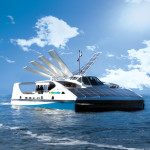![]() You read the title of this post, and the original paper, correctly. Brian H. sent this little gem of a paper to me today. Using SeaWiFS data from the last nine years, Polovina et al. show that in the North and South Pacific and Atlantic areas of low surface chlorophyll are in expanding by 0.8-4.3% per year. These areas have replaced higher surface chlorophyll with low surface area. The total expansion of these areas equals 6.6 million km2 (roughly 2/3 the size of the U.S.). The figure below shows a time series and regression line for the area with surface chlorophyll less than or equal to 0.07 chl/m3 in (a) quarter 4 in the North Pacific, (b) quarter 1 in the North Atlantic, and (c) quarter 3 in the South Pacific where you can clearly see the increase. A map is below the fold. The really, really bad news
You read the title of this post, and the original paper, correctly. Brian H. sent this little gem of a paper to me today. Using SeaWiFS data from the last nine years, Polovina et al. show that in the North and South Pacific and Atlantic areas of low surface chlorophyll are in expanding by 0.8-4.3% per year. These areas have replaced higher surface chlorophyll with low surface area. The total expansion of these areas equals 6.6 million km2 (roughly 2/3 the size of the U.S.). The figure below shows a time series and regression line for the area with surface chlorophyll less than or equal to 0.07 chl/m3 in (a) quarter 4 in the North Pacific, (b) quarter 1 in the North Atlantic, and (c) quarter 3 in the South Pacific where you can clearly see the increase. A map is below the fold. The really, really bad news
The expansion of the low chlorophyll waters is consistent with global warming scenarios based on increased vertical stratification in the mid-latitudes, but the rates of expansion we observe already greatly exceed recent model predictions.
Apparently it is getting harder to find food in the deep.
Polovina, J.J., Howell, E.A., Abecassis, M. (2008). Ocean’s least productive waters are expanding. Geophysical Research Letters, 35(3) DOI: 10.1029/2007GL031745







